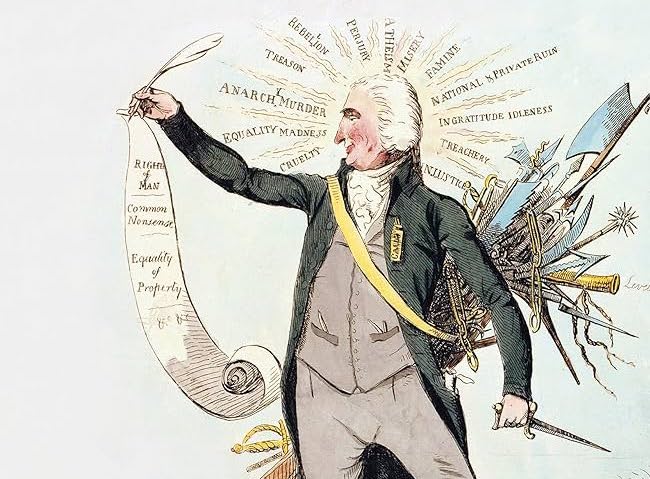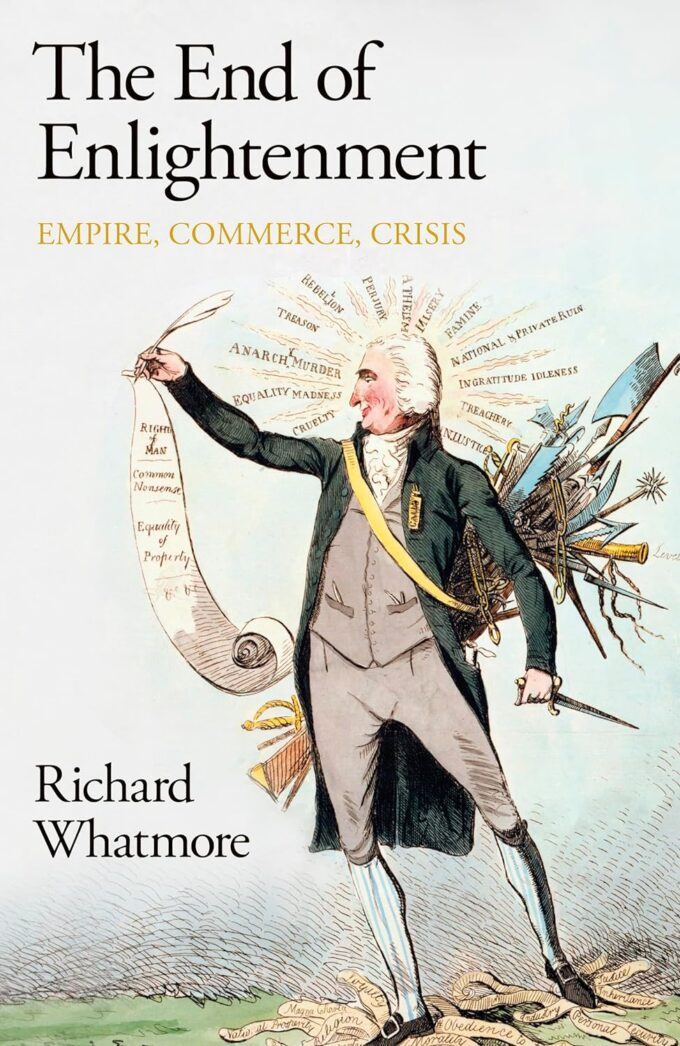How did a single chapter from a book written over six decades ago by a Black psychiatrist, who never discussed the Israel-Palestine issue, become widely cited in relation to October 7?
By Etan Nechin
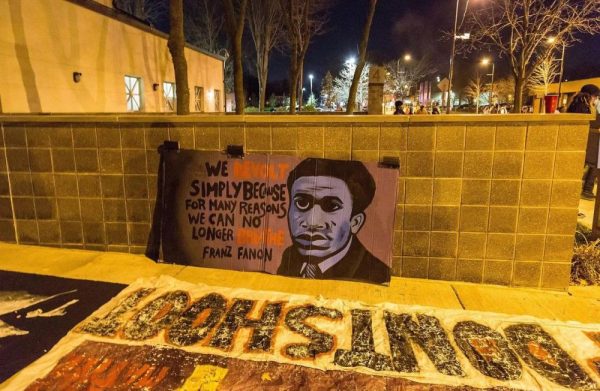
A banner quoting Frantz Fanon outside the Minneapolis Police Department following a police shooting in 2015: "We revolt simply because for many reasons we can no longer breathe." Credit: Tony Webster
On the morning of October 7, as images of the torn fence between the Gaza Strip and Israel proliferated on social media, so too did quotations by Frantz Fanon.
The writings of this Martinique-born philosopher, psychiatrist and leftist, who is noted for his work on racism, anti-colonialism and violence, have become emblematic of Algeria’s struggle for independence from France in the 1950s and early ’60s. On Black Saturday, his quotes were used to argue that the massacre conducted by Hamas was a direct and inevitable reaction to “colonial” oppression by Israel. One of the most-quoted lines that day, taken from Fanon’s seminal work “The Wretched of the Earth,” states: “Colonialism is not a thinking machine, nor a body endowed with reasoning faculties. It is violence in its natural state, and it will only yield when confronted with greater violence.”
Fanon, whose life was cut short at age 36 in 1961, has posthumously lent his voice to an array of causes – stretching from America’s civil rights movement to Pan-Africanism, resonating particularly with Black Lives Matter and pro-Palestinian activists. “The Wretched of the Earth” and “Black Skin, White Masks” have entered the academic canon, regularly appearing on humanities department syllabi. For his champions, he occupies the role of post-colonial herald, a prophet of insurgency, articulating the sentiments of the downtrodden.
Yet the breadth of Fanon’s intellect and the nuances of his political stance often remain in the shadows for those who invoke him.
In his extensive new biography “The Rebel’s Clinic: The Revolutionary Lives of Frantz Fanon,” Adam Shatz ventures beyond the conventional view of Fanon as an icon of political violence and the Algerian revolution. He offers a three-dimensional portrait of the man, situating him within the context of his own life and times, while also engaging with the intellectual milieu that shaped – and was in turn shaped by – his revolutionary ideas.
There are existing biographies of Fanon, but Shatz – by day the U.S. editor of London Review of Books – says he was motivated to write his because he felt that none of the others “had captured the passion, the tragic passion, of Fanon’s life in psychiatry, activism and writing.”
“Fanon was somewhat of a dreamer, a utopian, who thought that the upheaval of revolution or the shock of violence could address deep-seated issues. This didn’t happen.”
In an interview at his Brooklyn home, he says he sought to write something “that would situate Fanon in a larger group of writers and revolutionaries addressing the same predicament: not only how to dismantle the colonial order, but to create something better in its place. A powerful additional motivation was the Trump presidency, and the unfolding drama in France over Islam, ‘integration,’ police violence and jihadism – the embers of Algeria could still be felt there.”
West Indian skin, French mask
The book’s opening chapters explore the genesis of Fanon’s philosophy, mapping it back to his youth and the stark contrast between the profound disjunction between his nascent hopes and the realities he later confronted. It illustrates how his theories were a synthesis of thoughts crafted in solitude at his writing desk and those forged in the wider arena of social and political engagement.
Fanon was born in the French West Indies to a middle class family in July 1925. Initially, he did not even perceive himself as Black; he identified as French – a sentiment echoed by all of his peers on the island of Martinique. The phrase “nos ancêtres les Gaulois” (“Our ancestors the Gauls”) was a mantra for Martinican children like Fanon, despite their African heritage.
The complexities of race and class on the island influenced Fanon, particularly the “pigmentocracy” that permeated society. However, his family’s relative comfort shielded him to some extent – until the Vichy government’s arrival in 1940 unveiled a more sinister side of France characterized by racism and fascism.
This prompted the teenage Fanon to volunteer for the Free French Forces, where he confronted a colonial army rife with racial hierarchies. Despite being treated as an “honorary European” (Fanon was injured and received the Croix de Guerre military decoration), he saw firsthand the disparities in how Arabs and Africans were treated, and grappled with the irony of fighting against Nazism in an army practicing its own form of racial supremacy.
This contradiction was Fanon’s first jolt toward political consciousness, a feeling reinforced after the war when he faced rejection from French women who refused to dance with a Black liberator.
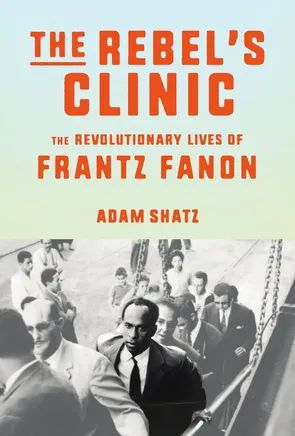
The U.S. cover of “The Rebel’s Clinic: The Revolutionary Lives of Frantz Fanon” by Adam Shatz. Credit: Farrar, Straus and Giroux
After his release from the army, these experiences drew him to Négritude – a cultural and political movement among French-speaking Black intellectuals that emphasized African values and heritage, and protested colonialism and racial discrimination. He was also drawn to the works of Aimé Césaire, the Martinican poet, playwright and politician who would become his first mentor. Fanon moved to France to continue his studies, eventually enrolling in medicine at the University of Lyon, where he specialized in psychiatry.
“A pivotal moment for Fanon occurred in France, described in ‘Black Skin, White Masks,’ when a little white boy is traveling on the train with his mother and points to Fanon and says ‘Look maman, a nègre.’ Here’s a little boy and yet he’s already a ‘racial expert’: he already comes to associate a Black man like Fanon with danger, with menace, and Fanon realizes that in the eyes of the French, he is a Black man,” Shatz says. “He is not simply a French man of color, as he was raised to believe; he does not enjoy the anonymity of a typical French person. And I think that is certainly the primal scene in Fanon’s work.”
This incident challenged Fanon’s belief in the French promise of color blindness and propelled him toward exploring various philosophies. These included Negritude, Senegalese statesman and poet Léopold Sédar Senghor’s mystical understanding of Black consciousness, and eventually European existential philosophy – which he found in the pages of Les Temps Modernes, the magazine edited by Jean-Paul Sartre and Simone de Beauvoir.
“You have to imagine Fanon as a man on a quest for identity during his time in Lyon. He found himself in a city that felt desolate, markedly homogeneous in its demographic, save for a small community of North African men. As a physician, Fanon came to treat these individuals. And in doing so, they left a significant imprint on his evolving sense of self,” Shatz notes.
Intrigued by iconoclastic psychiatric thinkers aligned with Marxism and surrealism who delved into madness in provocative ways, Fanon saw psychiatry’s goal as liberating individuals from internal complexes that obstructed their social interactions. He characterized mental illness as a “pathology of freedom,” devising his own discourse on restoring a person’s sense of identity and belonging, particularly after experiences of marginalization or mental health challenges.
In Lyon, Fanon’s encounters with North African migrant workers led to a pivotal realization about the “pathology of colonialism and racism.” Recognizing that these diagnoses overlooked the deeper, systemic issues stemming from oppression, Fanon was inspired to develop his concept of disalienation. This approach aimed not only to heal individual psychological distress, but also to address and mend the collective trauma caused by colonial and racist structures. This revelation bridged Fanon’s medical practice with his anti-colonial activism, forming a foundational element of his broader philosophical and political work.
“Fanon didn’t invent anything or create new concepts; he was a bricoleur, crafting a syncretic language from psychiatry, Negritude, phenomenology and anti-colonialism. The language he developed is highly distinctive, though the concepts are often used for convenience,” Shatz explains.
I think Afro-pessimism and decolonial thought share the same kind of historical fatalism that defines much of Zionism. For classical Zionism, a Jew in exile is living in a kind of hell, where it’s always possibly 1939.
Adam Shatz
“Fanon’s work, while deeply invested in the collective endeavor of liberation from the shackles of colonial dominance, economic exploitation and political oppression, does not solely focus on these broader societal issues. He also maintains a profound interest in the psyche of the individual, advocating for the liberation of colonized individuals from psychological complexes such as despair, passivity, feelings of futility and a perceived incapacity to influence historical events,” he says. “It’s important to recall that Fanon is not simply a revolutionary who infuses his political writings with psychiatric insights. He is a revolutionary critic of psychiatry.”
Although Fanon’s first book, 1952’s “Black Skin, White Masks,” was born from this period, Shatz writes that “it is neither a memoir nor a clinical study, but rather an unusual mixture of genres and discursive registers: analytic and poetic, despairing and hopeful, solemn and sarcastic.”
The biographer places “Black Skin, White Masks” within the broader historical and intellectual era, capturing the post-World War II revolutionary spirit that swept through Europe and the developing nations of the “global south.” On a journey of self-discovery, Fanon began to reject his initial mentors. This period was marked by national liberation movements, the influence of Marxism and the push for decolonization – a context within which Fanon found resonance and, ultimately, his place.
The guise of normality
Eleven months before the Algerian War of Independence began in November 1954, Fanon started working at a psychiatric institute just outside of Algiers. “Fanon didn’t come to Algeria as a revolutionary but a colonial administrator,” says Shatz. “It was not uncommon for France to send ‘assimilated’ West Indian professionals to the colonies to serve as examples of all the good things France had done for the natives, to serve as models for Africans,” he adds sarcastically.
“From the moment France colonized Algeria in 1830, it took the French approximately 40 years to ‘pacify’ the country – an endeavor the French considered pacification, but which for Algerians was a brutal invasion. During this period, about one-third of the Algerian population was decimated by violence and disease. By 1848, amid ongoing colonization efforts, France had divided Algeria into three departments and began governing the land as an integral administrative part of France itself, effectively transforming Algeria into an extension of France. Despite this, Algerians were not granted the rights of French citizens; they were subjects and were not recognized as citizens until the final stages of French rule.
“Algerians were violently uprooted, their lands confiscated, their language relegated to that of a foreign tongue and they were, in essence, turned into spectators within their own territory. For Fanon, these experiences of dispossession, violence and alienation constituted a profound psychological trauma. As I suggest in my book, Fanon perceived colonialism not merely as an oppressive regime, but as a pathological system that presented itself under the guise of normality.”

Frantz Fanon and his medical team at the Blida-Joinville Psychiatric Hospital in Algeria, where he worked from 1953 to 1956. Credit: Frantz Fanon Archives / IMEC
Shatz demonstrates how Fanon’s work shaped his thought and vice versa – whether implementing his radical psychiatric approaches on Algerian patients, or traveling to the Algerian backwoods where he witnesses local rituals and becomes enamored with the rural Algerians. When the war begins, Fanon knows which side he’s on: he is no longer a Frenchman.
“He begins to think of himself as an Algerian. He’s not a Muslim; he’s an atheist. He’s not an Arab; he’s a Black man from the West Indies. And yet he begins to develop this fusional relationship with the Algerian struggle – and in the course of that, he reimagines what it means to be Algerian. He thinks of Algerian nationalism as a kind of nationalism of the will, a nationalism that anyone can join. Arabs and Muslims, who are colonized of course, but also European sympathizers – or, for that matter, members of the Jewish minority,” Shatz says.
Initially, Fanon sought to join the Algerian National Liberation Front as a soldier, but the movement utilized his medical and intellectual expertise in other critical ways. He operated a covert clinic to treat wounded Algerian fighters, contributed writings to the army’s El Moudjahid publication and took on a variety of roles, including acting as an ambassador for the provisional Algerian government. This period of his life followed his expulsion from Algeria in 1956, during which time he resided in Tunis and Accra (where he served as the movement’s traveling ambassador in Africa).
Shatz paints a broad picture of the region and portrays Fanon’s relationships with Algerian revolutionaries, white French Marxists who came to support the revolution, and African leaders such as Patrice Lumumba. He also highlights the blind spots that Fanon, in his zeal, either overlooked or dismissed – including the Islamic component of the Algerian struggle.
It’s impossible to know what Fanon would have said about the Oct. 7 attack. But I don’t think Fanon would have been surprised by the fact that it happened. That the violence of oppression inevitably provokes the counterviolence of the oppressed is, after all, a Fanonian theme.
Adam Shatz
“Fanon, I think, imagined that the anti-colonial revolution might provide the kind of modernization that the French were claiming to bring with their civilizational project,” Shatz says. He highlights an essay Fanon wrote in 1959 called “Algeria Unveiled”: “It’s a captivating essay that explores the evolving symbolism of the veil,” his biographer says. “For Fanon, the veil can represent both subjugation and resistance. Fanon believed that through their revolutionary actions – like the Algerian women who planted bombs for the National Liberation Front – these women were not only fighting against colonialism but also challenging patriarchy.
“He hoped that, post-independence, Algerian men would recognize and embrace the women’s rights to freedom and equality. However, the outcome was different. While there’s a vibrant feminist movement in Algeria, the societal changes Fanon hoped for were not fully realized. Fanon was somewhat of a dreamer, a utopian, who thought that the upheaval of revolution or the shock of violence could address deep-seated issues. This didn’t happen.”
Apostle of violence
One of the issues facing Shatz as a biographer was Fanon’s aversion to documenting his private life. “He kept things close to the chest. He expressed disdain for those who wrote memoirs, viewing it as a bourgeois pastime,” he says. “The only real traces of Fanon’s personal life emerge in fleeting passages in his work, often masked by the use of the royal we pronoun. Fanon’s reluctance to write about himself makes the task of his biographer particularly challenging.”
Yet while the book may not contain new archival discoveries about Fanon, its depth is enhanced by the relationships Shatz fostered over the years with individuals close to Fanon. These include Algerian historian Mohamed Harbi, Algerian psychoanalyst Alice Cherki and, most notably, the late Marie-Jeanne Manuellan, Fanon’s secretary and confidante – aka Fanon’s “tape recorder” – who typed “The Wretched of the Earth” from his dictations.
Shatz, 51, has a rich history in journalism and a deep connection to the regions Fanon wrote about. Coming from a left-leaning, secular Jewish family in Massachusetts, his fieldwork took him to Algeria, the Palestinian territories, Lebanon and Egypt. His published works include “Prophets Outcast: A Century of Dissident Jewish Writing about Zionism and Israel” and “Writers and Missionaries: Essays on the Radical Imagination.” In recognition of his contributions to French culture, in 2021 he was named a knight of the Order of Arts and Letters. In this book, Shatz weaves together those years of travel, encounters and intellectual explorations into Fanon’s world, in all its contradictions and complexities.
No Fanon work has generated more debate than “The Wretched of the Earth,” which was published in 1961, the year of his death. It is a trenchant analysis of the psychological and cultural impacts of colonialism, advocating for decolonization and the liberation of oppressed peoples. It presents a powerful critique of colonial rule and a call to arms for revolutionary change, rooted in Fanon’s own experiences in Algeria.
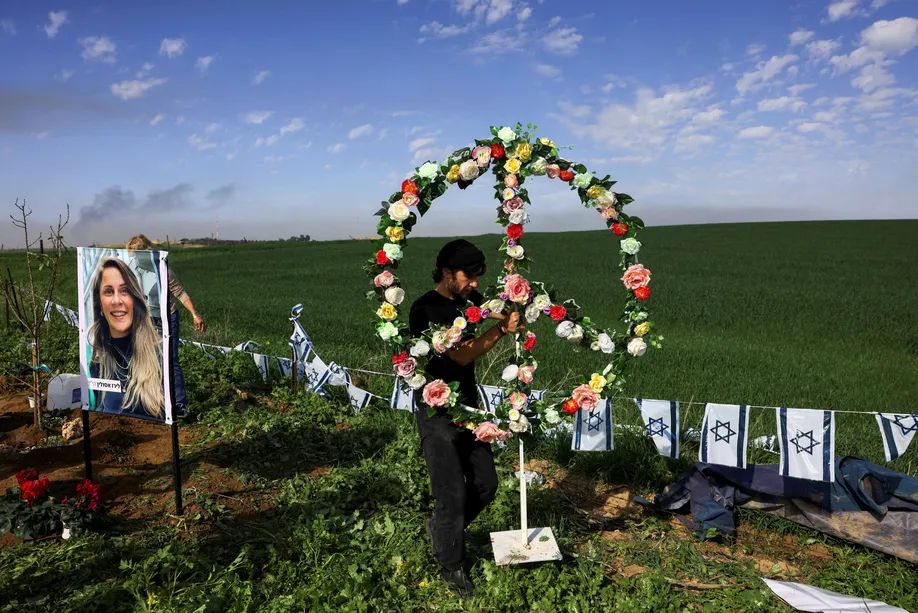
The family of Liraz Assulin, who was killed by Hamas terrorists while attending the Nova music festival on Oct. 7, creating a memorial for her near Kibbutz Kfar Azza last month. Credit: Ronen Zvulun/Reuters
Fanon had a talent for revolutionary phraseology, for what you might call revolutionary jingles. Thus, one can read them very selectively and find support for one’s argument – in this case, the ‘Al-Aqsa Flood’ – as a classic example of Fanonian struggle.
Adam Shatz
Its first chapter, “On Violence,” is also its most discussed. In it, Fanon discusses the role of violence in the decolonization process, arguing that it has a regenerative force for the oppressed to reclaim their humanity and overthrow the colonial system. He views violence as a cathartic response to the violence enacted by the colonizer and a crucial component in the struggle for liberation.
While many readers saw “The Wretched of the Earth” as nothing but a call to wanton violence, settling the score with the “master” – as many of his appalled contemporaries did – Shatz offers a more complex analysis.
For instance, he draws attention to a passage from “The Wretched of the Earth” where Fanon addresses this directly: “Racism, hatred, resentment and the ‘legitimate desire for revenge’ alone cannot nurture a war of liberation.”
In Shatz’ understanding of Fanon’s thinking, there is a tension between Fanon the doctor, whose first commandment is “do no harm,” to the revolutionary for whom violence is a way of achieving liberation.
“The longest chapter in the book is ‘On Violence.’ But the second longest chapter is ‘Colonial Warfare and Mental Disorders,’ which is an absolutely wrenching chapter where he writes not only about the impact of colonial violence on the colonized after independence. He also writes about the impact of anti-colonial violence on anti-colonial fighters who are haunted by the acts that they’ve committed,” the author says.
Shatz doesn’t argue that Fanon shies away from violence, but that his exploration of violence is phenomenological, focusing on the lived experience and the psychological transformation it brings about – such as a sense of empowerment or regeneration. This viewpoint is not unique to Fanon and is common in nationalist movements.
Furthermore, Shatz highlights Fanon’s poetic inclination, influenced by Negritude poets and his Caribbean background, which infuses his work with rich metaphors and a deep connection to historical struggles against oppression like the 18th-century Haitian Revolution.
Shatz contends that the misinterpretation of Fanon is partly due to the incorrect translation of the term “violence” as “cleansing” rather than “disintoxicating,” which Fanon intended to describe as an unfortunate but necessary step in the journey toward decolonization and reclaiming identity.
That misreading is attributed partly to Sartre’s militant preface to the book, in which he infamously stated: “To shoot down a European is to kill two birds with one stone – to destroy an oppressor and the man he oppresses at the same time.”
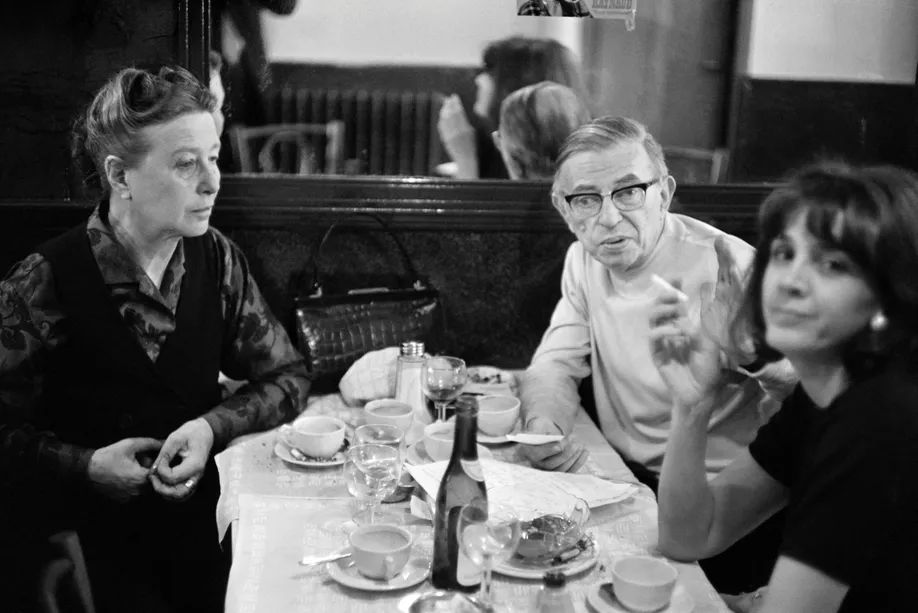
Simone de Beauvoir, left, and Jean-Paul Sartre at a Parisian restaurant in 1970. Credit: AFP
Fanon’s afterlife
Since Fanon’s death from leukemia and double pneumonia in December 1961, just seven months before Algeria’s independence, there have been numerous misuses and misreadings of his work. Shatz addresses this in an epilogue dedicated to Fanon’s posthumous influence, exploring how his ideas have been referenced and absorbed in various fields.
This epilogue includes subchapters on Fanon’s impact on Black liberation movements, psychiatry, post-colonial literature, the European migration discourse, pan-African and East Asian revolutionary thought, and Palestinian liberation – even though Fanon never directly wrote about either Palestine or Israel.
Fanon’s specter is invoked so frequently that Shatz has continued to expand on this epilogue even after his book was officially completed. A few weeks after the Hamas attack, Shatz wrote a piece in London Review of Books called “Vengeful Pathologies,” in which his nuanced application of Fanon’s theories in the context of the Israeli-Palestinian conflict, particularly regarding Hamas’ actions on Oct. 7, transcend a simplistic interpretation of Fanon as merely advocating violence.
Instead, Shatz uses Fanon to delve into the psychological ramifications of colonization and the complex motivations behind the use of violence in liberation struggles.
As for why Fanon is suddenly so prevalent, Shatz observes that he “had a talent for revolutionary phraseology, for what you might call revolutionary jingles. Thus, one can read them very selectively and find support for one’s argument – in this case, the ‘Al-Aqsa Flood’ – as a classic example of Fanonian struggle. The textual evidence is there. Just as Marx has been reduced to class struggle, and Freud to the unconscious and the Oedipus complex, so Fanon has been reduced to violence. And like Marx, he has lent himself to both vulgar and sophisticated readings.
“It’s impossible to know what Fanon would have said about the Oct. 7 attack,” Shatz continues. “But I don’t think Fanon would have been surprised by the fact that it happened. That the violence of oppression inevitably provokes the counterviolence of the oppressed is, after all, a Fanonian theme. As he writes in ‘The Wretched of the Earth’: ‘The colonized person is a persecuted person who dreams constantly of becoming the persecutor.’ Whether he would have endorsed this kind of attack, however, one can only speculate. A militant reader of Fanon might say that he would have, and there are grounds for making this claim. But ‘The Wretched of the Earth’ is also full of warnings about the danger of turning hatred and revenge into a political program, and Fanon insists that an anti-colonial struggle must overcome the ‘primitive Manichaeism’ of the colonial system.”
The renaissance of Fanon comes at a time when, according to Shatz, certain styles of thought – such as Afro-pessimism and the decolonial movement – have tended to substitute ontology for history. “Instead of seeing these identities as products of history and as entities that can be unmade, they view them as fixed and essential. Thus, the person who is the child, the grandchild or the great-grandchild of a colonized nation is somehow eternally colonized. Right? The notion is that anti-Black oppression is something that can never be transformed; it’s simply an irreducible, ontological part of societies under Western domination.
“I think Fanon was very skeptical of this style of thought – which, by the way, has a lot in common with Zionism. I think Afro-pessimism and decolonial thought share the same kind of historical fatalism that defines much of Zionism. For classical Zionism, a Jew in exile is living in a kind of hell, where it’s always possibly 1939. The only authentic life is among Jews in Israel. And I think there are many parallels. To me, that all speaks of the great doubt that has fallen over so many societies – most societies, arguably – that there is any horizon beyond what we know today.”
“The Rebel’s Clinic: The Revolutionary Lives of Frantz Fanon” (Farrar, Straus and Giroux), by Adam Shatz, is out now.


